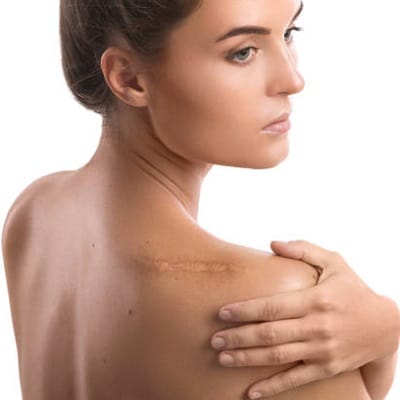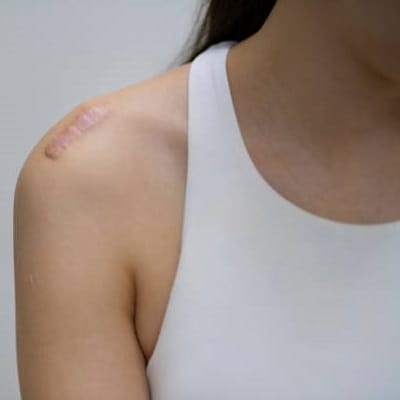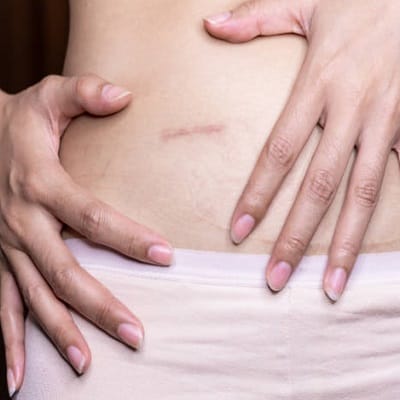
Keloids in Islamabad are Lesions described by elevated, hard skin edges that develop over the site of a skin wound. Connective tissue gradually replaces normal scar tissue, causing minor disturbances. Scar tissue is different; it continues to grow and can be much larger than the wound that caused it. They are usually oval, and smooth, and may be glossy; depending on the natural skin color they range from pink to dark brown.
Therefore, In this blog, we will help you determine the right treatment for the scar, depending on your circumstances.
What Causes Keloids?
The skin produces excess collagen, a protein essential for skin repair, resulting in the formation of keloids. Above all, the excess of these growth factors makes the scar bigger than it should be. Common causes include:
- Surgical cuts
- Burns
- Acne scars
- Piercings or tattoos
- Small skin effects (like abrasion or insect stings).
After all, these skin conditions affect people with a dark complexion more frequently and they can develop anywhere on the body, but popular areas include the chest, shoulders, ear lobes, and face.
Common Symptoms of Keloids:
Scar Tissues are easy to identify due to their distinct characteristics:
- It may still increase in the years.
- Keloidosis can also feel firm to the touch or tender or even show signs of itching.
- Having initially been red or pink, keloids may also become darker as time passes.
Best Treatments for Keloid Skin:
However, when these are rubbed off or treated, they can regrow very difficulty. Here are some of the most effective options:
Corticosteroid Injections
Steroid injection is among the most frequent methods of therapy for keloids. Therefore, these injections help to lessen inflammation and any overproduction of collagen. So, Corticosteroids are the most used treatment as it is invasive and have better results in reducing the size of these.
Pros: It is efficient for most of the patients and fast in process.
Cons: Many repeat treatments are necessary for this type of procedure.
Laser Therapy
Laser therapy aims the light to remove the thickness and redness of keloids. The laser can reduce the size of the keloid and make it less prominent.
Pros: It causes no pain, assists the wound in healing, and has an appealing scar appearance.
Cons: It may take longer and may be costly.
Silicone Gel Sheets
You can also effectively use silicone gel sheets or silicone-based creams for keloid scar management. This is how these products help, with the concepts of skin hydration and faithful flattening of the scar involved.
Pros: Non-invasive, easy to use, no pain involved.
Cons: Requires long-term use, and results may vary.
Cryotherapy (Freezing)
Cryotherapy involves freezing the keloidosis with liquid nitrogen, which helps to reduce its size by breaking down the scar tissue. However, It is often used in combination with corticosteroid injections for better results. Although, It is especially useful for smaller keloids.
Pros: It is effective for smaller keloids, a relatively quick treatment.
Cons: It can cause temporary pain and discoloration, and multiple sessions may be needed.
Surgical Removal
In cases where the scar tissue is large or does not respond to other treatments, surgical removal may be an option. Therefore, the surgeon carefully cuts out the keloid and stitches the skin together to minimize the chances of forming lumps.
Pros: This will remove them completely and is effective for large keloids.
Cons: It has a high risk of repetition.
Radiation Therapy
Keloids can be prevented from returning after surgery by using radiation therapy. The area is given low-dose radiation to inhibit collagen overproduction. So, When other methods have failed, radiation therapy is used to treat particularly aggressive skin lumps.
Pros: An effective approach in preventing recurrence after surgery.
Cons: It has potential long-term side effects, and requires multiple treatments.
Which Treatment is Right for You?
The best treatment for keloids depends on various factors, including the size, location, and severity of the scar tissue, as well as skin type. Often, a combination of treatments provides the best results. Besides consulting with an aesthetic physician or a specialist in skin conditions. It is essential to determine the right approach for your keloidosis.
Preventing Keloids
It’s important to take steps to prevent them from forming. Here are some tips:
Avoid unnecessary skin trauma: Avoid piercings, tattoos, or surgical procedures that could trigger keloid formation.
Treat wounds early: Always wash cuts and scrapes to avoid end up with thick or large scars on your skin.
Use pressure dressings: If you have had any operation or received a wound due to an injury, you can talk to your doctor about the possibility of having pressure bands to reduce the formation of scar tissue.
Final Thoughts:
You can find a range of treatments for difficult and stubborn Keloids. Such as a corticosteroid injection, laser treatment, or surgery. Therefore, If you’re interested in having keloidosis removed in Islamabad, you can visit SKN Cosmetics and consult with our best aesthetic physicians to ask and the best treatment for your skin condition.


